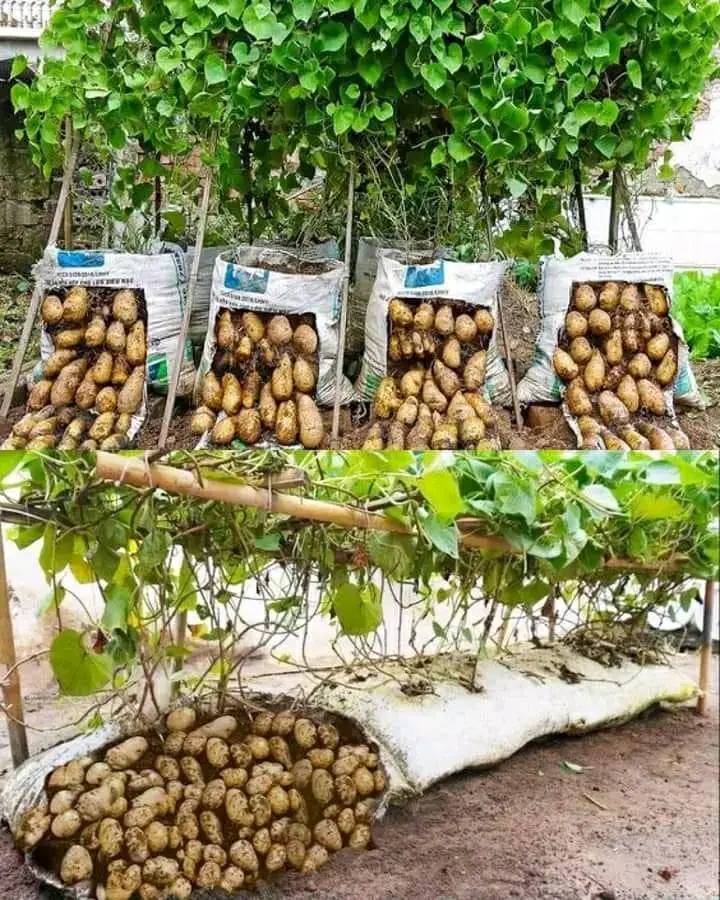Growing potatoes in containers is a fantastic way to enjoy fresh, home-grown produce even if you don’t have a traditional garden space. With the right techniques, you can achieve a bountiful harvest. Here’s a comprehensive guide to help you get started.
1. Understanding the Potato Lifecycle
Potatoes have a unique growth process that begins with sprouting ‘eyes’ on seed potatoes and ends with the formation of tubers underground. This lifecycle includes:
- Sprouting: Eyes on seed potatoes develop into sprouts.
- Plant Growth: Sprouts grow into green leafy plants.
- Tuber Formation: As the plant matures, tubers (potatoes) form underground.
Understanding this lifecycle helps you provide the right conditions for each stage of growth.
2. Choosing the Right Potato Variety
Select the variety of potatoes based on your regional climate and desired harvest time:
- Early Varieties: Mature in about 60-70 days. Ideal for short growing seasons.
- Mid-Season Varieties: Mature in 80-90 days. Good for most regions.
- Late Varieties: Take 90-120 days to mature. Best for areas with long growing seasons.
3. Prepping Seed Potatoes
Before planting, seed potatoes need to go through the ‘chitting’ process:
- Chitting: Place seed potatoes in a well-lit, cool area to encourage sprouting. Allow sprouts to grow to about 1-2 cm before planting.
4. Potato Planting Time
Timing is crucial for planting potatoes to avoid frost damage:
- Ideal Planting Time: Plant potatoes 2-4 weeks before the last expected frost date in your region. This timing allows the plants to establish before the warm season.
5. Selecting Containers
Choose containers that provide ample space and drainage:
- Grow Bags: Flexible and breathable, ideal for potatoes.
- Large Pots or Buckets: Ensure they have adequate drainage holes.
6. Planting and Soil Preparation
Proper soil preparation and planting techniques are essential for healthy growth:
- Soil Layering: Place a layer of soil at the bottom of the container.
- Positioning Sprouted Potatoes: Lay seed potatoes with the sprouted eyes facing up.
- Ongoing Soil Coverage: As the plants grow, add more soil to cover the stems, promoting tuber development.
7. Watering and Fertilization
Maintaining the right moisture level and providing nutrients is key:
- Watering: Keep the soil consistently moist but not waterlogged. Drip irrigation systems work well.
- Fertilization: Use organic fertilizers suitable for slightly acidic soil. Apply according to package instructions.
8. Sunlight Requirements
Potatoes need plenty of sunlight for optimal growth:
- Sunlight: Position containers in a spot that receives at least 6 hours of direct sunlight daily.
9. Harvesting Potatoes
Knowing when and how to harvest is crucial for maximizing your yield:
- New Potatoes: Harvest when the plants flower for smaller, tender potatoes.
- Mature Potatoes: Wait until the foliage dies back. Gently dig into the soil to collect the potatoes.
Tips for Storage:
- Cure Potatoes: Allow harvested potatoes to sit in a cool, dark place for about a week to toughen their skin.
- Storage: Store cured potatoes in a cool, dark, and well-ventilated area to prolong freshness.
By following these tips, you can successfully grow a healthy crop of potatoes in containers, ensuring a continuous supply of this versatile and nutritious vegetable. Enjoy the satisfaction of home-grown potatoes straight from your container garden!
